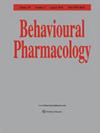Is impulsivity related to attentional bias in cigarette smokers? An exploration across levels of nicotine dependency and deprivation.
IF 1.6
4区 心理学
Q3 BEHAVIORAL SCIENCES
引用次数: 0
Abstract
Research has largely focused on how attentional bias to smoking-related cues and impulsivity independently influence the development and maintenance of cigarette smoking, with limited exploration of the relationship between these mechanisms. The current experiments systematically assessed relationships between multiple dimensions of impulsivity and attentional bias, at different stages of attention, in smokers varying in nicotine dependency and deprivation. Nonsmokers (NS; n = 26), light-satiated smokers (LS; n = 25), heavy-satiated smokers (HS; n = 23) and heavy 12-hour nicotine-deprived smokers (HD; n = 30) completed the Barratt Impulsivity Scale, delayed discounting task, stop-signal task, information sampling task and a visual dot-probe assessing initial orientation (200 ms) and sustained attention (2000 ms) toward smoking-related cues. Sustained attention to smoking-related cues was present in both HS and LS, while initial orientation bias was only evident in HS. HS and LS also had greater levels of trait motor and nonplanning impulsivity and heightened impulsive choice on the delay discounting task compared with NS, while heightened trait attentional impulsivity was only found in HS. In contrast, in HD, nicotine withdrawal was associated with no attentional bias but heightened reflection impulsivity, poorer inhibitory control and significantly lower levels of impulsive choice relative to satiated smokers. Trait and behavioral impulsivity were not related to the extent of attentional bias to smoking-related cues at any stage of attention, level of nicotine dependency or state of deprivation. Findings have both clinical and theoretical implications, highlighting the unique and independent roles impulsivity and attentional bias may play at different stages of the nicotine addiction cycle.吸烟者的冲动性与注意偏差有关吗?跨越尼古丁依赖和贫困水平的探索。
研究主要集中于对吸烟相关线索的注意偏差和冲动性如何独立地影响吸烟的发展和维持,而对这些机制之间关系的探讨却很有限。目前的实验系统地评估了不同尼古丁依赖和剥夺程度的吸烟者在不同注意阶段的冲动性和注意偏差的多个维度之间的关系。非吸烟者(NS;n = 26)、轻度吸烟者(LS;n = 25)、重度吸烟者(HS;n = 23)和尼古丁依赖12小时的重度吸烟者(HD;n = 30)分别完成了巴拉特冲动量表、延迟折现任务、停止信号任务、信息采样任务和视觉点探测任务,评估了对吸烟相关线索的初始定向(200毫秒)和持续注意(2000毫秒)。与NS相比,HS和LS的特质运动冲动和非计划冲动水平更高,在延迟折现任务中的冲动性选择更强,而只有HS的特质注意冲动更强。与此相反,与饱食吸烟者相比,尼古丁戒断者没有注意偏差,但反射冲动性增强,抑制控制能力较差,冲动选择水平显著降低。在任何注意阶段、尼古丁依赖程度或剥夺状态下,特质冲动和行为冲动都与吸烟相关线索的注意偏差程度无关。研究结果具有临床和理论意义,强调了冲动性和注意偏差在尼古丁成瘾周期的不同阶段可能扮演的独特而独立的角色。
本文章由计算机程序翻译,如有差异,请以英文原文为准。
求助全文
约1分钟内获得全文
求助全文
来源期刊

Behavioural Pharmacology
医学-行为科学
CiteScore
3.40
自引率
0.00%
发文量
84
审稿时长
6-12 weeks
期刊介绍:
Behavioural Pharmacology accepts original full and short research reports in diverse areas ranging from ethopharmacology to the pharmacology of schedule-controlled operant behaviour, provided that their primary focus is behavioural. Suitable topics include drug, chemical and hormonal effects on behaviour, the neurochemical mechanisms under-lying behaviour, and behavioural methods for the study of drug action. Both animal and human studies are welcome; however, studies reporting neurochemical data should have a predominantly behavioural focus, and human studies should not consist exclusively of clinical trials or case reports. Preference is given to studies that demonstrate and develop the potential of behavioural methods, and to papers reporting findings of direct relevance to clinical problems. Papers making a significant theoretical contribution are particularly welcome and, where possible and merited, space is made available for authors to explore fully the theoretical implications of their findings. Reviews of an area of the literature or at an appropriate stage in the development of an author’s own work are welcome. Commentaries in areas of current interest are also considered for publication, as are Reviews and Commentaries in areas outside behavioural pharmacology, but of importance and interest to behavioural pharmacologists. Behavioural Pharmacology publishes frequent Special Issues on current hot topics. The editors welcome correspondence about whether a paper in preparation might be suitable for inclusion in a Special Issue.
 求助内容:
求助内容: 应助结果提醒方式:
应助结果提醒方式:


